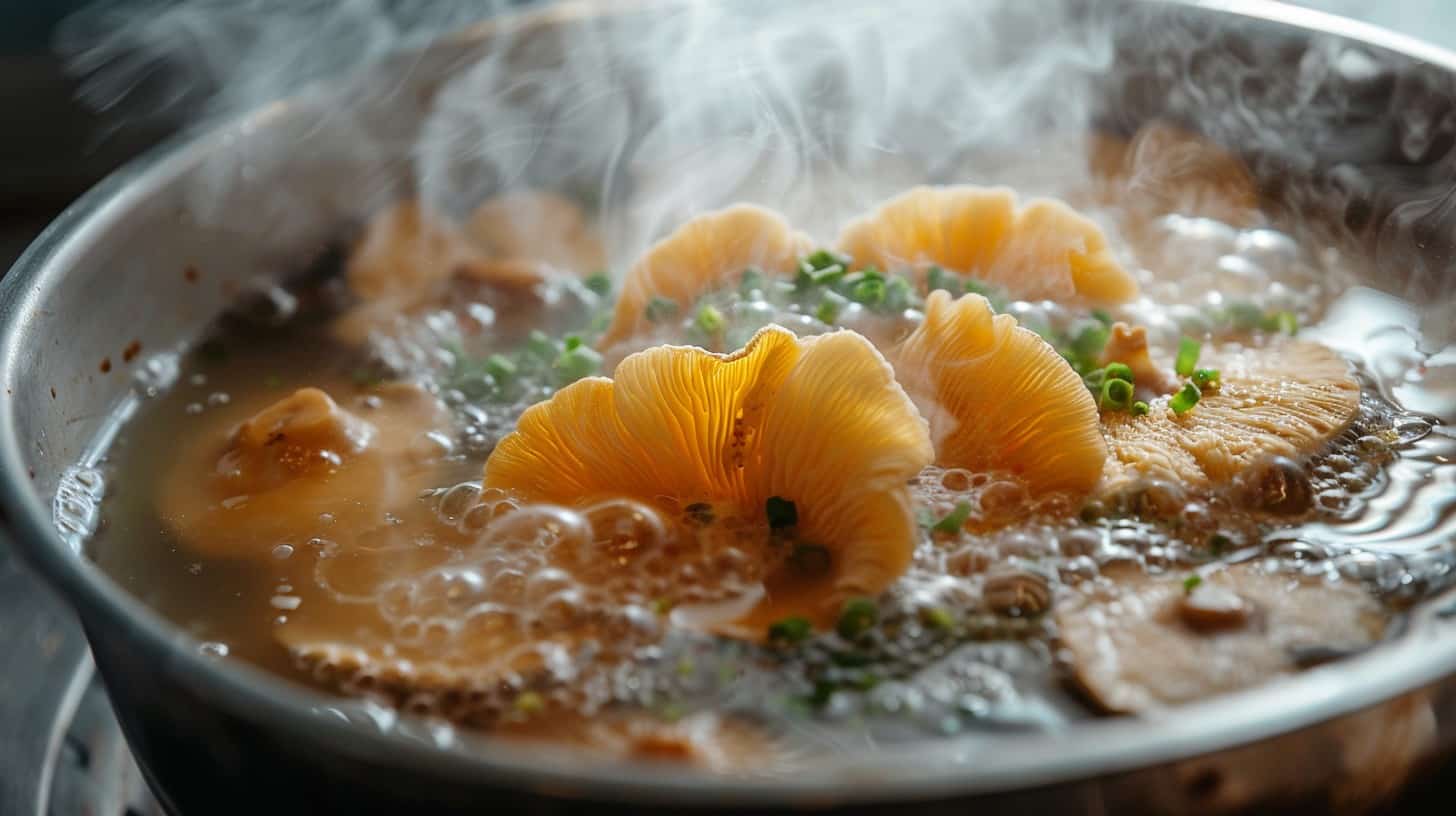Are you tired of the same old soups? Lion’s mane mushrooms can be your new go-to ingredient. Our guide will show you how to turn these fungi into a delicious soup that boosts health and flavor.
Get ready to slurp!
Key Takeaways
Lion’s Mane mushrooms are unique fungi that offer health benefits like improving brain function and boosting immunity. They have a meaty texture and seafood-like flavor, making them versatile in cooking.
To prepare Lion’s Mane for soup, gently wash and prep the mushrooms before sautéing with onions, garlic, and herbs to enhance their flavor. Use fresh or powdered forms depending on availability.
A variety of ingredients like onions, celery, carrots, kale, tofu or chickpeas can be used to make Lion’s Mane Mushroom Soup nutritious and filling.
Store Lion’s Mane mushrooms in a paper bag at room temperature for short periods or refrigerate for up to five days to keep them fresh.
Experiment with other mushroom types like portabello, oyster, or shiitake in soups for different flavors and added nutritional benefits.
Table of Contents
Overview of Lion’s Mane Mushrooms
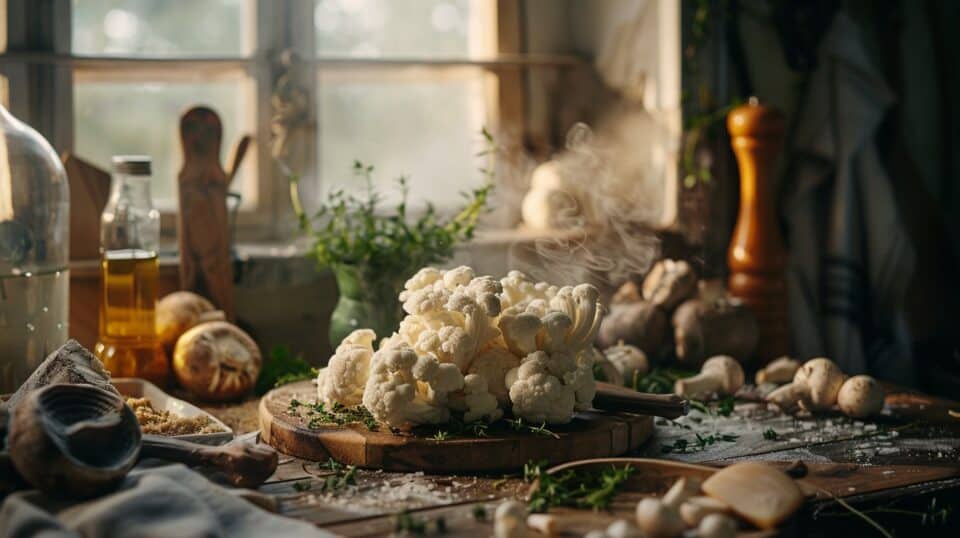
Lion’s Mane mushrooms look like white pom-poms hanging from trees. These fungi are not just cool to look at; they’re packed with stuff good for your brain and body, tasting a bit like seafood when you cook them up.
Appearance and Characteristics
Lion’s Mane mushrooms grab your attention with their unique look. They’re not your typical button or portobello mushrooms. Think of them as the hedgehogs of the mushroom world, with long, white spines that dangle like a waterfall.
This shaggy appearance is not just for show; it hides a meaty heart full of flavor and texture reminiscent of crab meat. Cooking these mushrooms transforms them into a hearty meal, offering a savory taste adventure unlike any other fungi out there.
Lion’s Mane: A culinary delight disguised as an unassuming hedgehog.
These mushrooms are also champions when it comes to versatility in the kitchen. You can sauté them for a stir-fry, bake them for a crunchy side dish, or simmer them in soups. And let’s talk storage – dehydrated and powdered Lion’s Mane can sit on your shelf, ready to sprinkle its umami magic into dishes at a moment’s notice.
Whether you’re whipping up something simple or diving into gourmet territory, this mushroom is ready to elevate your meal game.
Origins and Cultivation
Lion’s Mane mushrooms hail from North America, Europe, and Asia. They catch eyes at farmer’s markets with their white, shaggy coats that make them look like little lions. People grow these furry wonders both in the wild and on farms tailored for mushroom growth.
It’s a bit of magic seeing them pop up.
To cultivate Lion’s Mane, growers use spots rich in hardwood because these mushrooms love wood. Logs or sawdust blocks serve as homes where they can thrive. This method mirrors their natural habitat, letting them grow as if they were in the deep woods.
With patience and care, these unique fungi are ready to jump from forest to kitchen table.
Health Benefits and Nutritional Value
Chowing down on Lion’s Mane mushrooms isn’t just a treat for your taste buds; it’s like sending your brain to the gym. These fluffy fungi pack a punch against brain fog and help shield your noggin from diseases like dementia.
They’re not magic, but with powers to mend nerve damage and tackle both anxiety and depression, they’re close enough.
These mushrooms are also loaded with beta-glucans, a type of dietary fiber known for giving your immune system a boost. Think of them as your body’s personal cheerleaders, fighting off sickness left and right.
Plus, if you’re trying to keep heart disease or diabetes at bay, these mushrooms have got your back by reducing inflammation all around—pretty neat for something that grows on trees!
Flavor Profile and Culinary Uses
Lion’s Mane mushrooms pack a punch with their meaty, chewy texture that makes them perfect for soups and other dishes. They have a flavor that reminds people of seafood, especially crab or lobster.
This makes them great in recipes where you might use these kinds of seafood. Think swapping out crab for Lion’s Mane in your favorite risotto or stroganoff recipe. It can bring an umami taste to the table without adding any meat.
Cooking with Lion’s Mane isn’t just about the taste; it’s also about tapping into their health benefits. These mushrooms are not only delicious but come loaded with goodness that can help reduce stress and inflammation according to some studies.
From stir fries to sautéed dishes, there are countless ways on how to cook lion’s mane mushroom which make it easily adoptable into your cooking routine.
Turn up the heat and let those flavors mingle – cooking Lion’s Mane invites creativity into your kitchen.
Essential Ingredients for Lion’s Mane Mushroom Soup
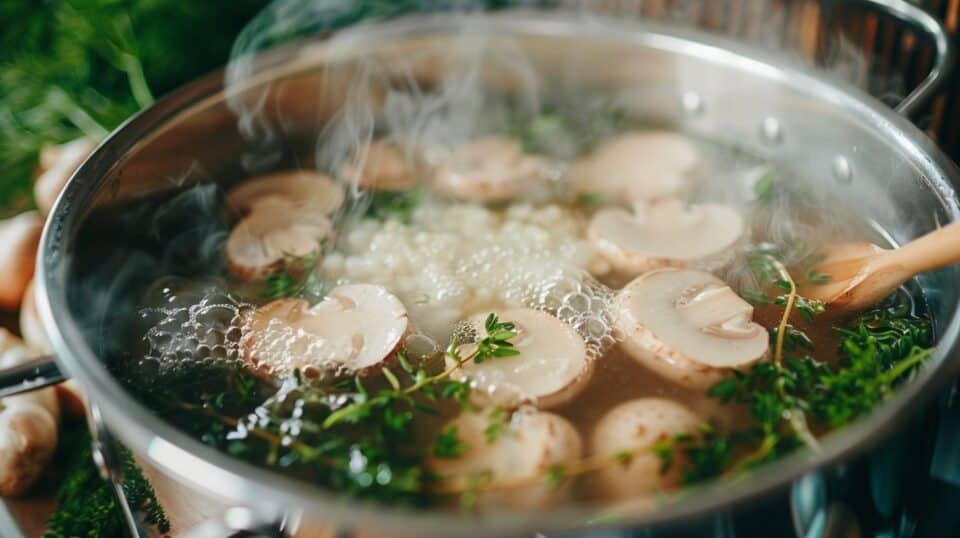
Cooking a tasty Lion’s Mane Mushroom Soup starts with gathering the right ingredients. This soup will not only fill your belly but also bring a bunch of health benefits to the table. Here’s what you need:
- Onions: They’re the base for any good soup, adding sweetness and depth. Chop them up fine and let them lead the flavor parade.
- Celery: Adds a fresh, slightly bitter taste that balances out the richness of the mushrooms. Slice it thin to spread its flavor in every spoonful.
- Carrots: For a touch of sweetness and lovely color, carrots are your go-to. Dice them into bite-sized pieces to make sure they cook through.
- Garlic: A few cloves will do the trick, minced well to fuse their pungent aroma into the broth, giving it that kick we all love.
- Kale: This green powerhouse brings nutrition and texture to your soup. Tear it by hand for rustic feel-good bites.
- Lion’s Mane Mushrooms: The star of the show, these fungi pack both flavors and an impressive array of health benefits, from boosting your brain to fighting off sickness.
- Alternative Options: Feel free to jazz things up with shredded oyster mushrooms or chopped button mushrooms if Lion’s Mane is hard to come by.
- Tofu or Chickpeas for protein: If you’re leaning towards more substance, chunky tofu cubes or chickpeas can make this soup a hearty meal on their own.
- Cauliflower: For those who like their soup chunky, adding cauliflower florets can introduce a delightful crunch and soak up flavors like tiny sponges.
With these essentials at hand, you’re all set to whip up a comforting bowl of Lion’s Mane Mushroom Soup that’ll warm hearts and boost health with every spoonful.
Preparing Lion’s Mane Mushrooms
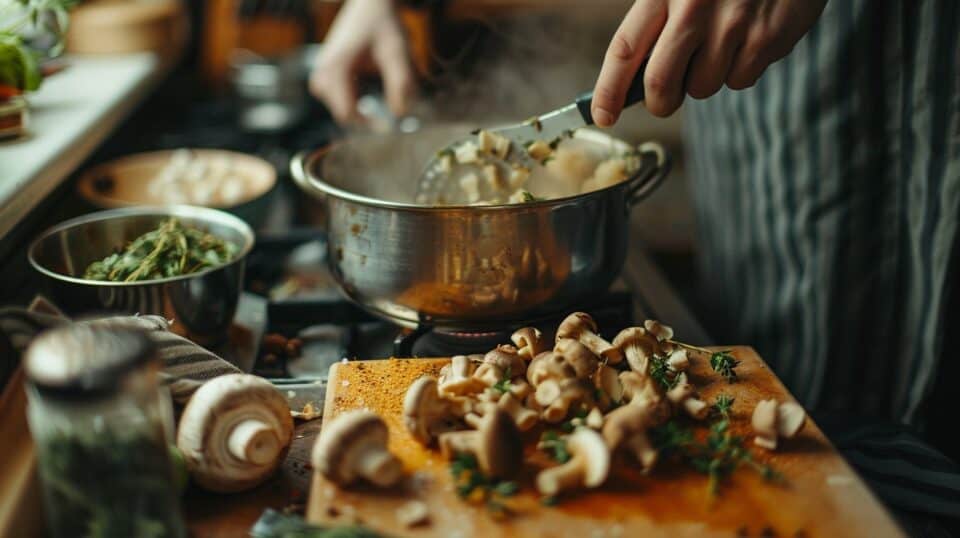
Getting Lion’s Mane mushrooms ready is like setting up a game board; it sets the stage for all the fun to come. First, give them a gentle wash under cool water, then pat them dry with a paper towel – no special tools or tricks needed, just your hands and some care.
Cleaning Techniques
Cooking starts with cleaning, especially when it comes to Lion’s Mane mushrooms. These fantastic fungi require a gentle touch to get them ready for your soup pot. Here’s how you make sure they’re clean and prepped:
- Give them a quick check. Look over your Lion’s Mane mushrooms for any dirt or debris clinging to their surface. Sometimes bits of their growing medium stick to the nooks.
- Use a soft brush or paper towel. Gently wipe away any dirt you find on the mushroom. This step is crucial because it avoids water logging the mushroom, which can change its texture.
- If brushing doesn’t do the trick, opt for a quick rinse under cold water. Hold the mushroom under running water but don’t soak it. Immediately after, gently pat it dry with a clean towel.
- Trim if necessary. Sometimes, you might find tough parts at the base where the mushroom was attached to its growing block or wood. Use a knife to trim these parts away.
- Slice or tear according to recipe needs. Once your Lion’s Mane is clean and trimmed, cut it into pieces as your recipe directs, or tear it into shreds by hand for that traditional soup texture.
Now that your mushrooms are prepped and ready, let’s move on to cooking this nutrient-packed ingredient into a delicious soup everyone will love!
Storage Tips
To keep your Lion’s Mane mushrooms fresh, stick them in a paper bag. This works great at room temperature for a quick day or two. Got a bit more time? Slide them into the fridge. They’ll stay happy and fresh there for up to five days.
After cooking these tasty fungi, seal them tight in an airtight box. They’ll be good as new in your fridge for another five days.
A well-stored mushroom is like a treasure tucked away, waiting to enrich your next meal.
Keep it simple with storage – no need for fancy gadgets or tricks. A regular kitchen fridge and some paper bags are all you need to protect those flavors and nutrients until you’re ready to cook again.
Cooking Lion’s Mane Mushroom Soup: A Step-by-Step Guide
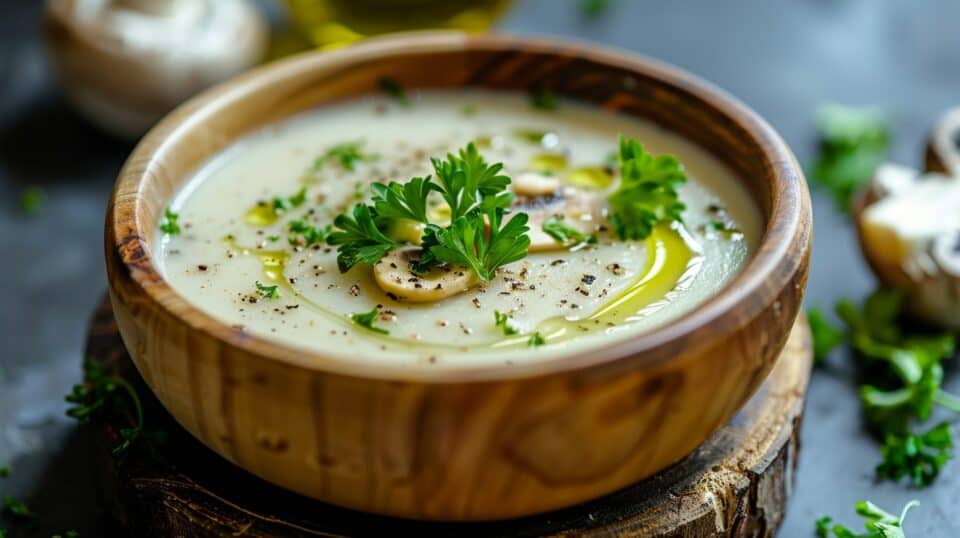
Ready to make your kitchen smell amazing? Grab a pot and let’s get started on this Lion’s Mane Mushroom Soup.
Preparation Tips for Enhanced Flavor
To get the most out of Lion’s Mane mushrooms in your soup, a good sauté is key. Heat some oil or butter in a pan over medium heat. Toss in chopped onions until they’re soft and golden.
This base adds depth to the flavor. Then, add minced garlic for that punchy aroma. Garlic should turn fragrant but not browned; it’s all about hitting that sweet spot.
For an umami boost, a splash of soy sauce works wonders with Lion’s Mane mushrooms. Soy sauce brings out their meaty texture, making them even more satisfying as a substitute for chicken.
To thicken your soup without losing flavor, consider using roux—a mixture of flour and fat cooked together—before adding your stock and veggies. It makes the broth beautifully rich and silky.
Keep stirring while cooking to meld flavors together perfectly.
Use fresh herbs like parsley towards the end of cooking. They bring freshness and brighten up the whole dish without overpowering other tastes.
Recipe: Lion’s Mane Mushroom, Broccoli, and Potato Soup
Cooking with Lion’s Mane mushrooms turns an ordinary soup into a dish that’s both delicious and nutritious. This recipe for Lion’s Mane Mushroom, Broccoli, and Potato Soup will have everyone asking for seconds.
Gather your ingredients: powdered dried or fresh Lion’s Mane mushrooms, onions, potatoes, broccoli, olive oil, garlic, sea salt, black pepper, broth (vegetable or chicken for a non-vegan option), milk (dairy or plant-based), lemon juice, and your choice of garnishes like fresh herbs.
- Heat a large pot over medium heat. Add olive oil.
- Throw in diced onions. Stir until they’re soft and golden.
- Add minced garlic. Cook it until it smells amazing but not burnt.
- Toss in the Lion’s Mane mushrooms. These mushrooms cook fast—just 4 minutes!
- Chop the potatoes into bite-sized pieces. Add them to the pot.
- Cut broccoli into florets. Throw those in too.
- Pour in your chosen broth. Make sure it covers the veggies well.
- Bring everything to a boil. Then reduce heat to let it simmer.
- Remember to stir now and then. After about 20 minutes, check if the potatoes are tender.
- Blend part of the soup for thickness if you like it less chunky. You can use an immersion blender right in the pot.
- Stir in milk slowly for creaminess. Heat through but don’t boil again.
- Squeeze some lemon juice in there. It adds a nice zing!
- Season with sea salt and black pepper to taste.
- Ladle hot soup into bowls. Garnish with whatever herbs you love—parsley works great here.
- Serve this hearty soup hot—maybe with crusty bread on the side.
Serving Suggestions for Lion’s Mane Mushroom Soup
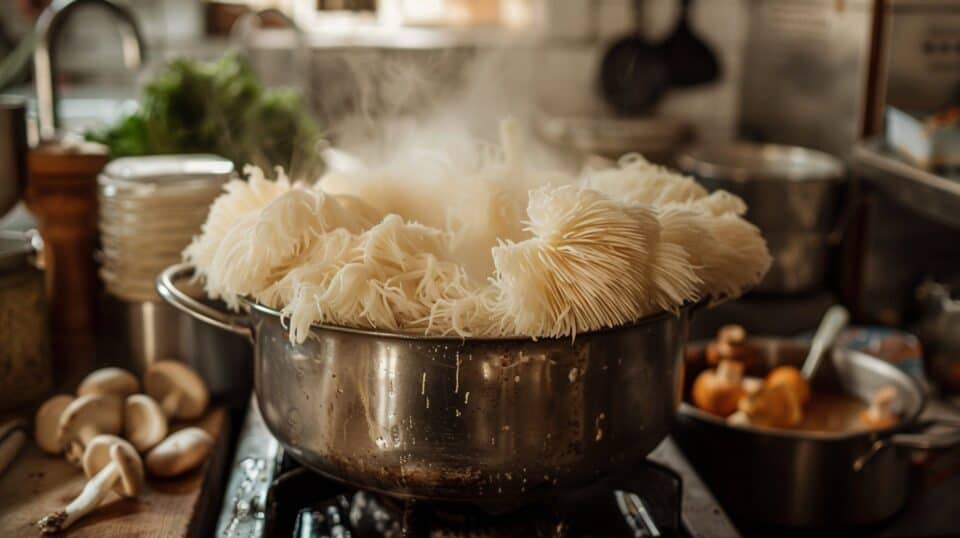
Pour this delicious Lion’s Mane Mushroom Soup into your favorite bowl and garnish with fresh parsley. A sprinkle of chives adds a nice touch too. This soup pairs well with a slice of crusty bread for dipping or a side green salad for a complete meal.
If you like, add a dollop of spicy mayo on top for an extra kick.
For those who enjoy exploring flavors, try adding miso or Dijon mustard into the soup base. It will give it an umami flavor that’s hard to beat. Serve this hearty soup as is or alongside grilled firm tofu slices for added protein.
Whether you’re enjoying a quiet dinner at home or serving guests, this soup is sure to impress without needing fancy plating techniques.
Exploring More Mushroom Varieties for Soup
There’s a whole world of mushrooms out there ready to jazz up your soup. From the hearty portobello to the delicate oyster, each type brings its own flair. Portobellos can mimic beef with their meaty texture, making them perfect for stews that need some bulk.
If you’re aiming for something lighter, oysters add a lovely mild flavor without overwhelming your dish. And let’s not forget about shiitakes; they offer a smoky touch that pairs wonderfully with miso or vegetable broths.
Don’t be afraid to mix and match these fungi in your next batch of soup. Experimenting with combinations like button and cremini can uncover flavors you never knew you were missing.
Adding these to recipes not only boosts taste, but also pumps up nutritional value, offering more vitamins and minerals in every spoonful. So grab your cutting board and sharpen those knives—it’s time to elevate your soup game by inviting more mushrooms into the pot!
FAQs About How to Cook Lion’s Mane Mushroom in Soup
What’s the big deal about Lion’s Mane mushroom in soup?
Lion’s Mane, or Hericium erinaceus if you’re fancy, isn’t just another mushroom. It’s a game changer for soups! Imagine tossing a meat substitute into your pot that not only thickens the broth but also packs an anti-inflammatory punch. Perfect for those on a plant-based diet or anyone looking to jazz up their meals.
Can Lion’s Mane mushrooms really help with health issues?
Absolutely! These hedgehog-looking wonders are not just for show. They’re known to reduce inflammation and may even give your immune response a boost—music to the ears of anyone battling heart problems or type 2 diabetes. Plus, they’re edible gold for folks watching their weight.
How do I cook Lion’s Mane mushroom in soup without turning my kitchen into a disaster zone?
Fear not! Start by giving them a quick sauté in some olive oil until they’re golden brown – this unlocks flavors you didn’t know existed! Then, plunge them into your simmering pot of goodness. Whether it’s a hearty stew or a delicate egg drop soup, these mushrooms play well with others.
Is there more than one way to use Lion’s Mane mushrooms in cooking?
Oh, you bet! Beyond soups and stews, these versatile fungi can strut their stuff in stir-fries, as stand-ins for steaks on the grill, or even get cozy under breadcrumbs as fake meat patties. Got leftovers? Toss them into pastas or salads tomorrow.
Will adding Lion’s Mane mushrooms make my food taste weird?
Not at all! Think of them as culinary chameleons—they soak up whatever flavors you throw at them like sponge cakes soaking up syrupy goodness. With a texture akin to seafood when cooked right, they might just be the secret ingredient your dishes have been missing.
What should I keep in mind when buying Lion’s Mane mushrooms for my soup?
Grabbing these fuzzy gems fresh from your local farmer is always best—Carnation, WA has some great picks if you’re nearby! But if fresh ones elude you like socks disappearing in the laundry room; fear not: freeze-dried versions have got your back and still pack that healthy punch we love so much.
